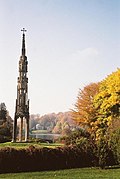Scheduled monuments in Bristol
 From Wikipedia - Reading time: 6 min
From Wikipedia - Reading time: 6 min
There are 165 scheduled monuments in Bristol, England.[1] These protected sites date from the Neolithic period in some cases and include barrows, a historic shipyard, ancient Roman sites, castle ruins, a Jewish burial structure, bridges, and lighthouses.[2] In the United Kingdom, the scheduling of monuments was first initiated to ensure the preservation of "nationally important" archaeological sites or historic buildings. Protection is given to scheduled monuments under the Ancient Monuments and Archaeological Areas Act 1979.[3]
Notable scheduled monuments in Bristol
[edit]| Image | Name | Location | Date | Notes |
|---|---|---|---|---|

|
Blaise Castle Estate | Near Henbury in Bristol | 18th century | The estate includes Blaise Castle House, a Grade II* listed 18th-century mansion house and Blaise Castle, a folly built in 1766.[4] |

|
Bristol Castle vaulted chambers | Bristol | 11th century | Built during the reign of William the Conqueror, it was an important royal castle that was the setting of several executions.[5] |

|
Bristol High Cross | Bristol | 14th century | A market cross erected in 1373 in the centre of Bristol. It was built in Decorated Gothic style on the site of an earlier Anglo-Saxon cross,[6] |

|
Fairbairn steam crane | Bristol | 1875 | The Fairbairn type jib crane was designed and patented by Sir William Fairbairn in 1850. This type of crane bettered existing designs in that the projecting arm allowed the crane operator to reach further into the hold of a ship and it was light in weight compared to the weight it could lift.[7] |

|
Bet tohorah at Jacob's Wells Road | Cliftonwood, Bristol | 12th to 13th century AD | Early medieval structure used as a cleansing house in Jewish burial ceremonies. Generally associated with Jewish burial grounds. [8] |

|
Kings Weston Roman Villa | Lawrence Weston, Bristol | late 3rd century AD | Roman villa uncovered during the construction of the Lawrence Weston housing estate in 1947.[9] |

|
The Old Lighthouse, Lundy | Lundy island, Bristol Channel | 1819 | Known as "Old Light". An abandoned lighthouse on the highest point of Lundy, it is the oldest of the three Lundy lighthouses. It includes the lightkeeper's house and a small complex of buildings within a walled enclosure.[10] |

|
St Mary le Port Church, Bristol | Bristol | Early Medieval era | St Mary's was established in the Anglo-Saxon period and later rebuilt between the 11th and 16th centuries. The church was bombed during a bombing raid in November 1940.[11] |

|
Quakers Friars | Broadmead, Bristol | 1227 AD | The friends meeting house was built in 1747–1749 on the site of a Dominican friary, Blackfriars, which was established in the early 13th century.[12] |

|
Temple Church, Bristol | Redcliffe, Bristol | 14th century AD | Ruined 14th century church built on the site of a previous circular church of the Knights Templar. Bombed and mostly destroyed during the Second World War.[13] |

|
Underfall Yard, Bristol Docks | Spike Island, Bristol | 1809 AD | A historic shipyard serving Bristol Harbour. It was generally referred to as "The Underfalls."[14] |
See also
[edit]References
[edit]- ^ "Scheduled Monuments: Search the List". Historic England. Retrieved 31 January 2023.
- ^ "Scheduled Ancient Monuments in the Historic County of Dorset". Ancient Monuments UK. Retrieved 28 January 2023.
- ^ "Scheduled Monuments". Historic England. Retrieved 28 January 2023.
- ^ Historic England. "Castle Lodge and Gateway, Blaise Castle Estate (1202278)". National Heritage List for England. Retrieved 1 February 2023.
- ^ Historic England. "Vaulted Chambers at Bristol Castle (1202476)". National Heritage List for England. Retrieved 1 February 2023.
- ^ Historic England. "Bristol High Cross (1005655)". National Heritage List for England. Retrieved 1 February 2023.
- ^ Historic England. "Fairburn-type crane, Wellington Dock (1004193)". National Heritage List for England. Retrieved 2 February 2023.
- ^ Historic England. "Bet tohorah at Jacob's Wells Road (1020792)". National Heritage List for England. Retrieved 1 February 2023.
- ^ "Monument Number 198239". Historic England: Heritage Gateway. Retrieved 2 February 2023.
- ^ Historic England. "The Old Lighthouse, Lundy (1016039)". National Heritage List for England. Retrieved 1 February 2023.
- ^ Historic England. "St Mary-le-Port Church (1021385)". National Heritage List for England. Retrieved 2 February 2023.
- ^ Historic England. "Dominican Friars (Quaker's Friars) (1007012)". National Heritage List for England. Retrieved 2 February 2023.
- ^ Historic England. "Temple Church (1015872)". National Heritage List for England. Retrieved 2 February 2023.
- ^ "Our Story: Underfall Yard". Underfall Yard. 7 June 2016. Retrieved 1 February 2023.
Licensed under CC BY-SA 3.0 | Source: https://en.wikipedia.org/wiki/Scheduled_monuments_in_Bristol18 views | Status: cached on July 21 2025 11:40:26↧ Download as ZWI file
 KSF
KSF